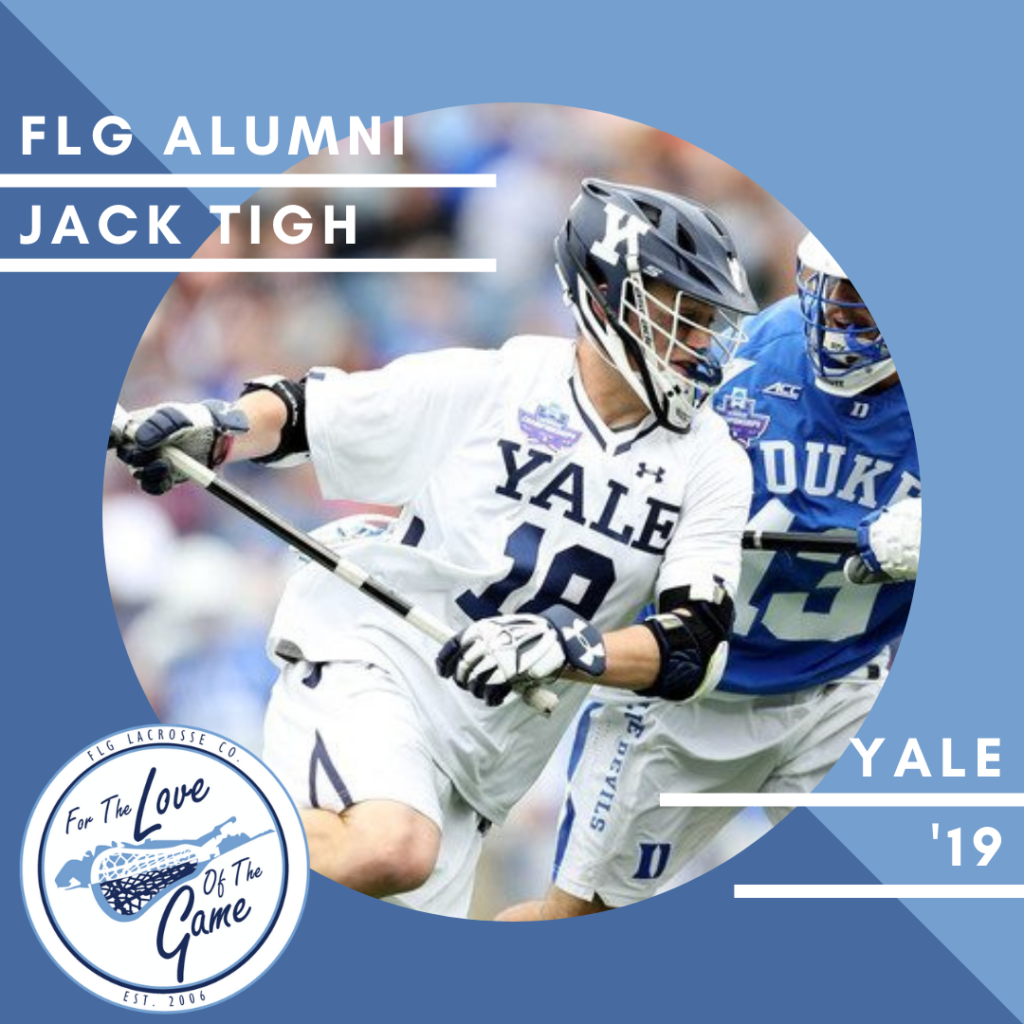FLG Alumni Jack Tigh balances playing at the highest level of lacrosse and a day job as an investment banker for Barclays. If that’s not impressive enough, the 2019 Yale graduate and New York Lizard, still finds time to train the next generation of players and prioritize an active lifestyle. Tigh credits much of his success on the field to growing up on Long Island and being a four-year varsity football and lacrosse player at Chaminade High School. One of his most favorite sport memories would be Yale’s 2018 NCAA Championship win over Duke. Tigh had three goals, and says the most rewarding feeling was seeing his parents happier than he was.
Q: What about Yale and its lacrosse program helped you decide it was the right school for you?
A: One of the main drivers in my decision was the Yale coaching staff. Andy Shay was a coach that went the distance in recruiting me. Shay constantly called to check-up on me and would tell me why Yale was the best fit. I realized this was the team I wanted to play for when the coaching staff drove all the way to Chaminade just to watch a practice. I wanted to give my all for a coach that gave me his.
The Chaminade players that came before my time also provided keen insights as to what Yale has to offer and the rich experiences that come with the school.
Q: How has your football background translated to your skills on the lacrosse field?
A: Teamwork is the most important attribute of football that I carried over to lacrosse. In order to succeed on the football field, it is pivotal that every player on the field knows the play call, play count, and their respective roles for each play. If everyone is working together, this leads to more opportunities to capitalize on situations to ultimately win the game. I found that in order to win these football games, everyone had to play together as one unit.
This translated well in lacrosse. Teamwork taught me that success is not valued based on the amount of points scored in a given game. What mainly attributed to the ‘W’ at the end of four quarters are the plays you make on both sides of the field to get there. I quickly learned that playing as a team was the catalyst to success.
Q: In what ways did growing up on Long Island, a hotbed for the sport, and attending Chaminade (with one of the best high school lacrosse programs), influence your journey to the Major League?
A: Growing up around the sport and watching my older brothers/sister play the game made me crave playing all the time. Living on Long Island makes it tough to not get involved in the sport. Your best friends constantly talk/watch/play it while wearing the cool club apparel for the team they play for (I always wore my FLG!).
This culture that I grew up in made me desire to compete at the highest level. I never thought I would play in any Major League game, let alone for the team that I grew up watching 10 minutes away from my home.
Q: How does playing professional lacrosse compare or differ from your collegiate program? How did it feel to be drafted by your hometown team?
A: Comparing college lacrosse to professional lacrosse is a good question. In the major league, you’re surrounded by people (from all ages) that love the sport just as much as you do, probably even more so. Just when you think your learning of the sport is done, you’re opened to a whole new world of players. Players that come from different college programs with different learning skills.
Being drafted by my home team was an awesome feeling. It was a sign of hope that my lacrosse days weren’t officially over given the demand in my new job. Being able to commute 10 minutes to and from practices/games made the experience that much more fun. I even had my college buddies (Joe Sessa and John Danigellis) who played on the Lizards with me over my house before a few games.
Q: Are there any particular coaches/teammates that taught you valuable lessons about lacrosse or life that you frequently keep in mind?
A: Eric Scott and Michael Keasey are two teammates of mine that taught me a valuable lesson when I was a sophomore. They emphasized that the most important part of the game is to just have fun with it. It’s common to get swept into a routine where you’re hard on yourself based on individual performance. Eric and Mike helped show that the more fun you have in practice, the better you will play.
Q: When you’re not on the lacrosse field, what are you likely to spend your time doing?
A: Hanging with friends and family, going to the beach, fishing and/or golfing.
Q: You focused on working this past summer and still find time to train the next generation of players. How do you balance your day job as an investment banker and your coaching/playing career?
A: I realized I can still make time to teach the youth despite the demand of my job. Whether it be a late night or weekend training session, I try to grow the game and share the knowledge I’ve learned.
Despite the intensity of the job, it’s crucial to make time for yourself and do the things that make you happy. For me, it is training kids.


